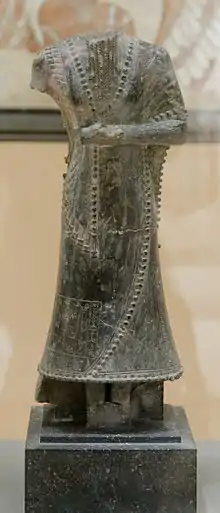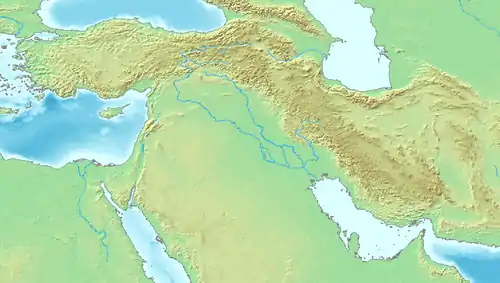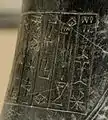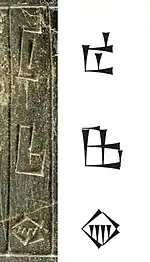Iddi-ilum
Iddi-ilum, also Iddi-El or Iddin-El (𒄿𒋾𒀭, i-ti-ilum, ruled 2090-2085 BCE),[1] was a military governor, or Shakkanakku, of the ancient city-state of Mari in eastern Syria, following the conquest, the destruction and the control of the city by the Akkadian Empire.[2]
| Iddi-ilum 𒄿𒋾𒀭 | |
|---|---|
| Military governor of Mari | |
 Statue of Iddi-Ilum | |
| Reign | c.2100 BCE |
| Predecessor | Apil-kin |
| Successor | Ili-Ishar |
| Dynasty | Shakkanakku dynasty |

Iddi-ilum was contemporary of the Third Dynasty of Ur, and probably their vassal.[3]
His headless statue, the Statue of Iddi-Ilum was discovered at the Royal Palace of Mari during excavations directed by French archaeologist André Parrot. The statue was made of soapstone and bears an inscription identifying the figure and dedicating it to the goddess Ishtar or Inanna. The statue is now displayed at the Musée du Louvre in Paris.[4]
The inscription on the statue reads:
"Iddi-ilum, Shakkanakku of Mari, for the goddess Ishtar dedicated a statue of himself. As for the one who removes this inscription, may the goddess Ishtar destroy his progeny"
Statue of Iddi-ilum
 The inscription on the bottom of the statue (front).
The inscription on the bottom of the statue (front). The inscription on the bottom of the statue (back).
The inscription on the bottom of the statue (back). "Country of Mari" (Cuneiform: 𒈠𒌷𒆠, Mari-ki), on the statue of Iddi-Ilum
"Country of Mari" (Cuneiform: 𒈠𒌷𒆠, Mari-ki), on the statue of Iddi-Ilum Iddi-Ilum, shagina Mari-ki
Iddi-Ilum, shagina Mari-ki
Apil-kin of Mari | ||
| Regnal titles | ||
|---|---|---|
| Preceded by Apil-kin |
Shakkanakku of Mari c.2090-2085 BCE |
Succeeded by Ili-Ishar |
References
- Leick, Gwendolyn (2002). Who's Who in the Ancient Near East. Routledge. p. 76. ISBN 978-1-134-78796-8.
- Beyond Babylon: Art, Trade, and Diplomacy in the Second Millennium B.C. Metropolitan Museum of Art. 2008. p. 30. ISBN 978-1-58839-295-4.
- Unger, Merrill F. (2014). Israel and the Aramaeans of Damascus: A Study in Archaeological Illumination of Bible History. Wipf and Stock Publishers. p. 5. ISBN 978-1-62564-606-4.
- Claire, Iselin. "The Statuette of Iddi-Ilum". Musée du Louvre. Retrieved 22 November 2012.
- Beyond Babylon: Art, Trade, and Diplomacy in the Second Millennium B.C. Metropolitan Museum of Art. 2008. p. 30. ISBN 978-1-58839-295-4.
- THUREAU-DANGIN, F. (1937). "Inscriptions Votives de Mari". Revue d'Assyriologie et d'archéologie orientale. 34 (4): 172–176. ISSN 0373-6032. JSTOR 23284118.